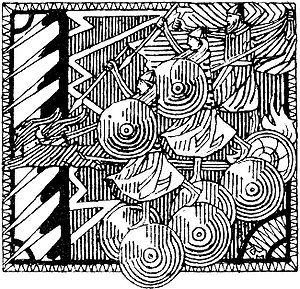Jómsvíkinga saga

The Jómsvíkinga saga ("Saga of the Jomsvikings") is a medieval Icelandic saga composed by an anonymous author. The saga was composed in Iceland during the 13th century. It exists in several manuscripts which vary from each other. There are many different versions and translations of the saga.[1][2]
The saga
At the time of writing,
History
There are five versions of the Jómsvíkinga saga that have been recovered over the years. The first, MS AM.291, is an incomplete manuscript written by an Icelander in the late thirteenth century. The second, MS AM. 510 4to, was written in the fifteenth century and contains much more information than the other versions. The third, Codex Holmanius 7, written in the fourteenth century, is shorter than the other versions and gives a brief summary of the saga. The fourth, Flateyjarbók, is a combination of the Jómsvíking saga and the Greater saga of Óláfr Tryggvason. Lastly, the fifth version, was a Latin translation of Arngrímr Jónsson written in the year 1592.[4]
Historians have found it difficult to classify the Jómsvíkinga saga among the Old Norse sagas. It is sometimes counted among the Kings' sagas based principally upon the association with Danish kings. Both the Kings' sagas and the Jómsvíkinga saga can be looked at through a political lens. [5] [6]
Popular culture
Jómsvíkinga saga served as inspiration for Henry Treece's novel Horned Helmet (1963).[7]
Translations
- The Saga of the Jomsvikings: Translated from the Icelandic with Introduction, Notes and Appendices, trans. by N.F. Blake (London: Thomas Nelson and Sons Ltd, 1962) (Nelson's Icelandic Texts)
- The Saga of the Jomsvikings: A Translation with Full Introduction, trans. by Alison Finlay and Þórdís Edda Jóhannesdóttir (Kalamazoo: Medieval Institute Publications, 2018), ISBN 978-1580443111.
See also
References
- ^ "Jómsvíkinga Saga The Saga of the Jomsvikings" (PDF). Translated by N.F. Blake. Thomas Nelson and sons, Ltd. 1962.
- ^ Słupecki, Leszek P. Facts and fancy in Jómsvíkinga saga in The Fantastic in Old Norse/Icelandic Literature: Preprint Papers of the 13th International Saga Conference (Durham: Centre for Medieval and Renaissance Studies, 2006)
- ^ Sirpa Aalto. "Jómsvíkinga Saga as a Part of Old Norse Historiography" (PDF). University of Oulu. Retrieved October 23, 2015.
- ^ N.F. Blake. The Saga of the Jómsvíkings. Thomas Nelson and Sons Ltd.
- ^ History and fantasy in Jómsvíkinga saga in The Fantastic in Old Norse/Icelandic Literature: Preprint Papers of the 13th International Saga Conference (Durham: Centre for Medieval and Renaissance Studies, 2006)
- ^ Alison Finlay. "Jómsvíkinga Saga and Genre" (PDF). Birkbeck College. Retrieved October 23, 2015.
- ^ "Database of medieval Icelandic saga literary adaptations". Christopher W. E. Crocker. 2019-02-23. Retrieved 2022-11-13.
Other sources
- Fløtre, Odd Karstein (2009) Jomsvikingslaget i oppklarende lys (Hatlehols AS) ISBN 978-82-92055-34-2
- Halldórsson, Ólafur (1993) Jómsvíkinga saga (Medieval Scandinavia: An Encyclopedia. Ed. Phillip Pulsiano et al., Routledge Encyclopedias of the Middle Ages; 343–44) ISBN 978-0824047870
- Blake, N.F. (1962) "The Saga of the Jómsvíkings" (Thomas Nelson and Sons Ltd)
Related Reading
- Hreinsson, Viðar (1997) The Complete Sagas of Icelanders (including 49 Stories) (Iceland: Leifur Eiriksson Publishing Ltd) ISBN 978-9979929307
External links
- Editions available from Old Norse Workfiles by Michael Irlenbusch-Reynard.
- Jómsvíkinga saga in Old Norse (with translations into other Scandinavian languages) from heimskringla.no
- The Jómsvíkinga saga in modern Icelandic from snerpa.is (text identical to the above)
